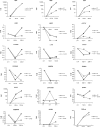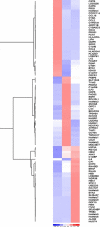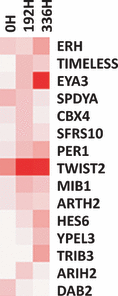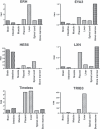Global gene expression reveals a set of new genes involved in the modification of cells during erythroid differentiation
- PMID: 20546246
- PMCID: PMC6496675
- DOI: 10.1111/j.1365-2184.2010.00679.x
Global gene expression reveals a set of new genes involved in the modification of cells during erythroid differentiation
Abstract
Objectives: Erythroid differentiation is a dynamic process in which a pluripotent stem cell undergoes a series of developmental changes that commit it to a specific lineage. These alterations involve changes in gene expression profiles. In this study, gene expression profiles during differentiation of human erythroid cells of a normal blood donor were evaluated using SAGE.
Materials and methods: Global gene expression was evaluated in cells collected immediately before addition of erythropoietin (0 h) and 192 and 336 h after addition of this hormone. Real-time PCR was used to evaluate activation of differentially expressed genes.
Results: The data indicate that global aspects of the transcriptome were similar during differentiation of the majority of the genes and that a relatively small set of genes is probably involved in modification of erythroid cells during differentiation. We have identified 93 differentially expressed genes during erythroid development, and expression of some of these was confirmed by qPCR. Various genes including EYA3, ERH, HES6, TIMELESS and TRIB3 were found to be homologous to those of Drosophila melanogaster and here are described for the first time during erythroid development. An important and unique carboxypeptidase inhibitor described in mammalians, LXN, was also identified.
Conclusions: The results of this study amplify previously published data and may contribute to comprehension of erythroid differentiation and identification of new target genes involved in some erythroid concerning diseases.
Figures





Similar articles
-
Interleukin-3 and erythropoietin cooperate in the regulation of the expression of erythroid-specific transcription factors during erythroid differentiation.Exp Hematol. 2007 May;35(5):735-47. doi: 10.1016/j.exphem.2007.02.007. Exp Hematol. 2007. PMID: 17577923
-
NKL Homeobox Genes NKX2-3 and NKX2-4 Deregulate Megakaryocytic-Erythroid Cell Differentiation in AML.Int J Mol Sci. 2021 Oct 22;22(21):11434. doi: 10.3390/ijms222111434. Int J Mol Sci. 2021. PMID: 34768865 Free PMC article.
-
Phosphatidylinositol 3-kinase/Akt induced by erythropoietin renders the erythroid differentiation factor GATA-1 competent for TIMP-1 gene transactivation.Mol Cell Biol. 2005 Sep;25(17):7412-22. doi: 10.1128/MCB.25.17.7412-7422.2005. Mol Cell Biol. 2005. PMID: 16107690 Free PMC article.
-
Role of helix-loop-helix proteins during differentiation of erythroid cells.Mol Cell Biol. 2011 Apr;31(7):1332-43. doi: 10.1128/MCB.01186-10. Epub 2011 Jan 31. Mol Cell Biol. 2011. PMID: 21282467 Free PMC article. Review.
-
Probing the onset and regulation of erythroid cell-specific gene expression.Mt Sinai J Med. 2005 Sep;72(5):333-8. Mt Sinai J Med. 2005. PMID: 16184297 Review.
Cited by
-
Differentiation is accompanied by a progressive loss in transcriptional memory.BMC Biol. 2024 Mar 12;22(1):58. doi: 10.1186/s12915-024-01846-9. BMC Biol. 2024. PMID: 38468285 Free PMC article.
-
Pan-cancer analysis reveals dual roles of HES6 in cancer immunity and prognosis.Discov Oncol. 2025 Jun 15;16(1):1110. doi: 10.1007/s12672-025-02852-1. Discov Oncol. 2025. PMID: 40517338 Free PMC article.
-
Global analysis of erythroid cells redox status reveals the involvement of Prdx1 and Prdx2 in the severity of beta thalassemia.PLoS One. 2018 Dec 6;13(12):e0208316. doi: 10.1371/journal.pone.0208316. eCollection 2018. PLoS One. 2018. PMID: 30521599 Free PMC article.
-
Thirty Years with ERH: An mRNA Splicing and Mitosis Factor Only or Rather a Novel Genome Integrity Protector?Cells. 2023 Oct 13;12(20):2449. doi: 10.3390/cells12202449. Cells. 2023. PMID: 37887293 Free PMC article. Review.
-
LSD1-mediated repression of GFI1 super-enhancer plays an essential role in erythroleukemia.Leukemia. 2020 Mar;34(3):746-758. doi: 10.1038/s41375-019-0614-6. Epub 2019 Nov 1. Leukemia. 2020. PMID: 31676828
References
-
- Baron MH (1997) Transcriptional control of globin gene switching during vertebrate development. Biochim. Biophys. Acta 1351, 51–72. - PubMed
-
- Shivdasani RA, Orkin SH (1996) The transcriptional control of hematopoiesis. Blood 87, 4025–4039. - PubMed
-
- Pope SH, Fibach E, Sun J, Chin K, Rodgers GP (2000) Two‐phase liquid culture system models normal human adult erythropoiesis at the molecular level. Eur. J. Haematol. 64, 292–303. - PubMed
-
- Hu M, Krause D, Greaves M, Sharkis S, Dexter M, Heyworth C et al. (1997) Multilineage gene expression precedes commitment in the hemopoietic system. Genes Dev. 11, 774–785. - PubMed
Publication types
MeSH terms
Substances
LinkOut - more resources
Full Text Sources

